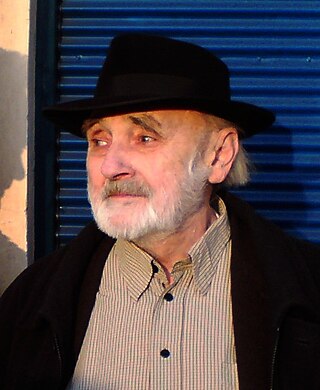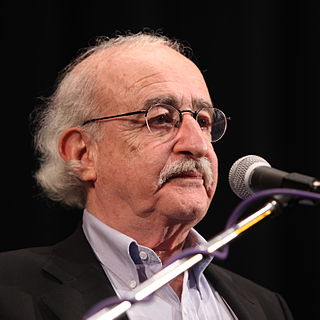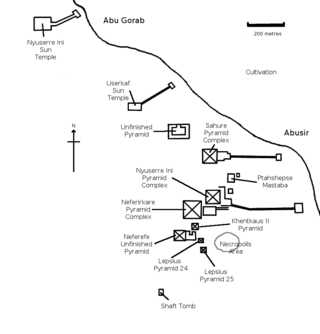Related Research Articles

Egyptology is the scientific study of ancient Egypt. The topics studied include ancient Egyptian history, language, literature, religion, architecture and art from the 5th millennium BC until the end of its native religious practices in the 4th century AD. A practitioner of the discipline is an "Egyptologist". In Europe, particularly on the Continent, Egyptology is primarily regarded as being a philological discipline, while in North America it is often regarded as a branch of archaeology.
James Henry Breasted was an American archaeologist, Egyptologist, and historian. After completing his PhD at the University of Berlin in 1894, he joined the faculty of the University of Chicago. In 1901 he became director of the Haskell Oriental Museum at the university, where he continued to concentrate on Egypt. In 1905 Breasted was promoted to full professor, and held the first chair in Egyptology and Oriental History in the United States.

Abusir is the name given to an ancient Egyptian archaeological pyramid complex comprising the ruins of 4 kings' pyramids dating to the Old Kingdom period, and is part of the Pyramid Fields of the Memphis and its Necropolis UNESCO World Heritage Site.

Miroslav Verner is a Czech egyptologist, who specializes in the history and archaeology of Ancient Egypt of the Old Kingdom and especially of the Fifth Dynasty of Egypt.

Labib Habachi was a Coptic Egyptian egyptologist.
Jaroslav Černý was a Czech Egyptologist. From 1929 to 1946 he was a lecturer and docent at Charles University in Prague, from 1946 to 1951, the Edwards Professor of Egyptology at the University College, London. From 1951 to 1965, he was Professor of Egyptology at University of Oxford.

Zbyněk Hejda was a Czech poet, essayist and translator.

Ptahshepses was the vizier and son-in-law of the Fifth Dynasty pharaoh Nyuserre Ini. As such he was one of the most distinguished members of the royal court. Ptahshepses' mastaba complex in Abusir is considered by many to be the most extensive and architecturally unique non-royal tomb of the Old Kingdom.

František Lexa (1876-1960) was a Czechoslovakian Egyptologist. Lexa began his career as a secondary school teacher. Having learnt the Egyptian language by himself, he became the first person to translate and publish Egyptian texts into Czech in 1905. Lexa spent the rest of his career at Charles University in Prague, first as a private senior lecturer of Egyptology in 1919, then an associate professor in 1922, then Czechoslovakia's first Professor for Egyptology in 1927, and finally the first director of the Czechoslovak Institute of Egyptology in 1958. Lexa's students included Jaroslav Černý and Zbyněk Žába.

Juraj Herz was a Slovak film director, actor, and scene designer, associated with the Czechoslovak New Wave movement of the 1960s. He is best known for his 1969 horror/black comedy The Cremator, often cited as one of the best Czechoslovak films of all time, though many of his other films achieved cult status. He directed for both film and television, and in the latter capacity he directed episodes of a French-Czech television series based on George Simenon's Maigret novels.

The Faculty of Arts, Charles University, is one of the original four faculties of Charles University in Prague. When founded, it was named the Faculty of the Liberal Arts or the Artistic Faculty. The faculty provides lectures in the widest range of fields of the humanities in the Czech Republic, and is the only university faculty in Europe which provides studies in all the official languages of the European Union. The faculty has around 1,000 members of staff, over 9,000 students, and a flexible system of more than 700 possible double-subject degree combinations.
Zbyněk is a Czech masculine given name. The Polish equivalent is Zbigniew.

The Abusir Papyri are the largest papyrus findings to date from the Old Kingdom in ancient Egypt. The first papyri were discovered in 1893 at Abu Gorab near Abusir in northern Egypt. Their origins are dated to around the 24th century BC during the Fifth dynasty of Egypt, making them, even though often badly fragmented, among some of the oldest surviving papyri to date. Later on, a large number of additional manuscript fragments were discovered in the area.
Herbert Rüdiger Ricke, was a German archaeologist, Egyptologist and architectural historian who is best known for his works on ancient Egyptian architecture.

Giovanni Kminek-Szedlo, née Jan Kmínek-Szedlo was a Czech–Italian Egyptologist.
He is usually remembered as the first Egyptologist from what nowadays is the Czech Republic but since he spent most of his life and fulfilled his whole career in Italy, he is usually not seen as the founder of Czech Egyptology, a figure rather identified in the later František Lexa.
Qakare Ini was an ancient Egyptian or Nubian ruler who most likely reigned at the end of the 11th and beginning of the 12th Dynasty over Lower Nubia. Although he is the best attested Nubian ruler of this time period, nothing is known of his activities.

Bohumil Bydžovský was a Czech mathematician, specializing in algebraic geometry and algebra.
Zbyněk Šidák was a Czech mathematician. He is known for developing the Šidák correction.
Fayza Mohamed Hussein Haikal is a professor emerita of Egyptology at the American University in Cairo and the first Egyptian woman to earn a PhD in Egyptology.
References
- ↑ "Čeští a slovenští orientalisté" . Retrieved 2009-02-24.
- 1 2 "Unearthing Ancient Egypt" (PDF). Czech Institute of Egyptology, Charles University. Retrieved 2009-02-24.